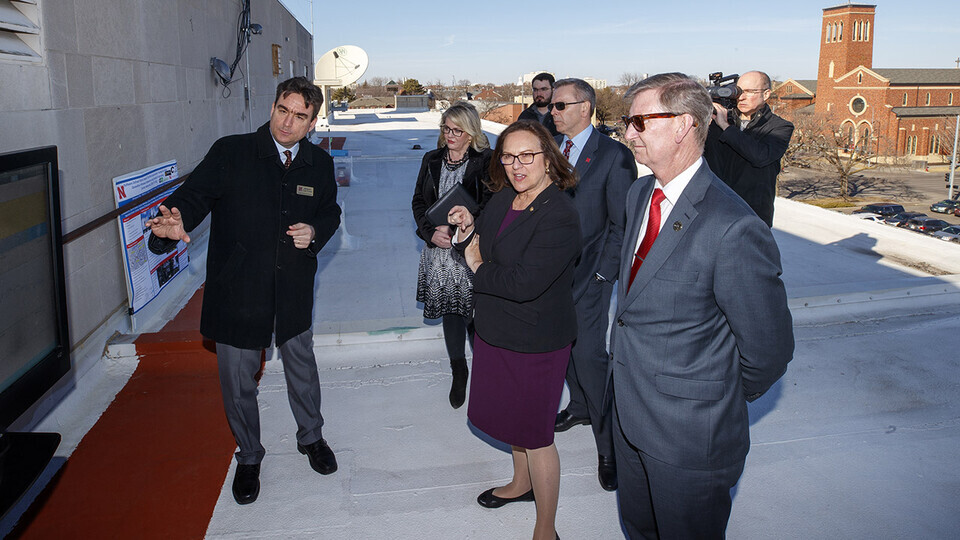
Lincoln, Neb. —A team of researchers and wireless technology experts from the University of Nebraska–Lincoln and the city of Lincoln, along with community, industry and university partners, has been selected as a finalist to lead a prestigious National Science Foundation research program focused on studying novel ways to reduce the cost of broadband delivery to rural communities.
NSF’s Platforms for Advanced Wireless Research program (PAWR) has three city-scale wireless research testbeds across the country. If awarded, the Nebraska Experimental Testbed of Things, known as NEXTT, would make Lincoln the fourth U.S. city to serve as a network testbed for expanding affordable broadband service and developing delivery models that could lower the cost of expanding coverage in rural areas. Iowa State University is the other finalist institution.
Rural, low-income areas throughout the U.S. still lag in the number of residents who subscribe to broadband internet, according to the U.S. Census Bureau. That issue is attributed to lack of broadband infrastructure, both wired and wireless, which is costly for companies to provide in less densely populated areas.
The NEXTT team’s goal is to develop and test advancements in rural wireless broadband connectivity. Its project focuses on integrating multiple wireless technologies and supporting a range of configurations for last-mile and backhaul network architecture, which could reduce costs for providers and improve the quality of connectivity for residents.
Husker researchers have deep expertise in developing wireless technologies in remote agricultural settings. Crop fields, ranches, rural towns and rural bridges throughout Nebraska have already proven to be assets for establishing connectivity hubs, said Mehmet Can Vuran, Susan J. Rosowski Professor of computer science and engineering, and the project’s principal investigator.
Chancellor Ronnie Green said recent events have demonstrated the importance of reliable, affordable broadband services for communities.
“Students need it to learn. Many workers depend upon it to maintain their livelihoods. Businesses large and small, urban and rural, require it to remain competitive,” he said. “This research testbed, if chosen for funding, would be an important component of the university’s commitment to meeting the needs of Nebraskans and, indeed, all rural Americans, in this crucial area.”
The team would leverage a longstanding partnership between the university and the city of Lincoln to improve connectivity in rural areas. Lincoln, part of the US Ignite-funded Smart Gigabit Communities network, is a national leader in developing state-of-the-art gigabit infrastructure that supports wireless needs for both homes and businesses. The city will serve as a testbed for technologies that could be used in rural settings.
“Our partnership with UNL and NSF represents the opportunity to build new 21st century broadband technologies in Lincoln,” Mayor Leirion Gaylor Baird said. “This partnership demonstrates our focus on a modern economic development strategy that allows us to grow technology and businesses to meet our community needs. Lincoln is a national leader in urban broadband. Our partnership will expand that leadership to rural broadband in Lancaster County and across the state of Nebraska, with the promise to deliver a positive impact throughout the country.”
Clay Center, Nebraska, is partnering with the research team to provide feedback on how wireless technologies perform in rural areas. Several University of Nebraska and U.S. Department of Agriculture research facilities are located near the town of 760.
“Advanced broadband connectivity would greatly enhance not only the U.S. Meat Animal Research Center and the Great Plains Veterinary Educational Center, but also Clay Center’s award-winning public library, new aquatic center and our residents — many of whom work remotely — and our farmers and ranchers,” said Nanette Shackelford, City Council president. “The city of Clay Center is highly supportive of this project and is poised to be an active partner.”
The university has received $300,000 in funding from the PAWR Project Office to further develop wireless platforms and strengthen resources to begin immediate work on the project in early 2021, if selected.
The 43-member NEXTT team includes researchers and experts from Nebraska, Ohio State University, Southern Methodist University, Rutgers University, the University of Kansas, the U.S. Meat Animal Research Center and Nebraska Educational Telecommunications. Additional university partners are NUtech Ventures, the Robert B. Daugherty Water for Food Global Institute and Nebraska Innovation Campus. Industry partners are ALLO Communications, Windstream, Nextlink Internet, Don’t Panic Labs, OPTK Networks, Olsson, SmallData Tech, NCEE Labs, Skylark Wireless and RealmFive Inc., among others. In addition to the city of Lincoln, community partners include Lincoln Public Schools and the Nebraska Department of Economic Development.







